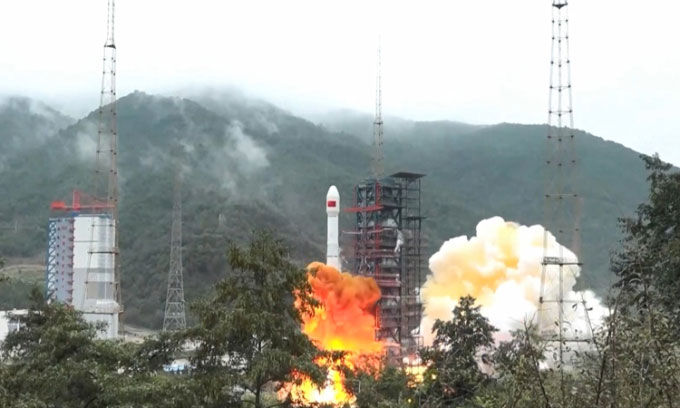Chinese satellite pulls another satellite out of orbit
The Shijian-21 satellite flew close to another decommissioned satellite and pulled it high, to a graveyard orbit for dead satellites.
Exoanalytic Solutions, a satellite tracking company contracted to provide data to the US Space Force in 2021, discovered the Chinese satellite Shijian-21 (SJ-21) disappeared from its normal orbit on January 22. .

The Long March 3B rocket launched the Shijian-21 satellite into space.
The SJ-21 then flew close to a decommissioned satellite of China's BeiDou Navigation System. Next, SJ-21 proceeds to pull this satellite out of geosynchronous orbit and then "escort" it higher, to the graveyard orbit for dead satellites, avoiding the risk of impact or collision touch with the active satellite.
"We continue to monitor and monitor SJ-21 to detect its association with any known space objects. The ability to maintain surveillance of SJ-21 after this satellite pull event is a possibility. unique and important capabilities of the commercial Spatial Situational Awareness (SSA) network at Exoanalytic Solutions," said Brian Flewelling, chief SSA architect at Exoanalytic Solutions.
SJ-21 flew into space on October 24, 2021 thanks to the Long March 3B rocket. This satellite is designed to test and verify technologies to reduce space junk.
Last November, experts discovered SJ-21 moving near an unidentified object, seemingly a deliberate synchronicity. China has not confirmed the object, but the US Space Force believes it may be a used AKM rocket engine. Others argue that it is an experimental device designed to test the capabilities of the SJ-21.
While the SJ-21 may only serve the purpose of peacefully shifting satellites, some experts fear the technology will be used to re-orbit any satellite, bringing it to a meaningful orbit. land or fly towards the Earth.
The US Space Force has also commissioned Northrop Grumman to develop a satellite with a robotic arm that can repair and relocate other satellites in orbit. Northrop Grumman has already tested the technology in space, and the fully operational device is scheduled to launch in 2024.
- Chinese missiles launched French satellites into orbit
- Chinese sponsors Bolivia installed the first satellite
- Iran is about to put 3 satellites into orbit
- China launched two satellites into space
- More than 1,200 satellites orbit the next 10 years
- Chinese private company first launched satellites into orbit
- America put satellite reconnaissance on orbit
- Reconnect with the old satellite
- Vinasat-2 has been on orbit
- VNREDSat-1 satellite must
- China successfully tried the satellite fueling system right on orbit
- China launched the moon probe satellite
 Vietnam 5th Asian champion on fuel-efficient vehicles
Vietnam 5th Asian champion on fuel-efficient vehicles We can read all NASA studies completely free of charge
We can read all NASA studies completely free of charge Singer and songwriter Bob Dylan won the 2016 Nobel Prize for Literature
Singer and songwriter Bob Dylan won the 2016 Nobel Prize for Literature Scientific revolution in Asia
Scientific revolution in Asia